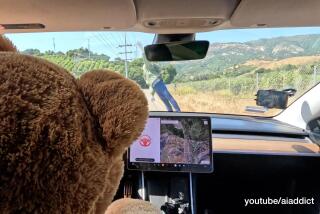Car review: 2013 Ford Escape thwarted by high tech
Ralph Waldo Emerson once said, “To be simple is to be great.” Memo to the minds behind Ford’s 2013 Escape: Read more Emerson.
At its core, this completely redesigned compact sport-utility vehicle is a great vehicle. It is comfortable, capable and not bad to look at.
Yet the $36,025 Escape Titanium four-wheel drive I tested piled on too many layers of unreliable technology. The effect was more instances of teeth-grinding, fist-clenching, guttural wails of undiluted anger than my blood pressure cares to admit.
The foot-activated power tailgate worked when it wanted to, the detection system for backing up was hyperactive, and the navigation system literally couldn’t find itself. This, in an age when GPS devices are so ubiquitous that I’m pretty sure there’s one on my washing machine telling me how to get to the dryer.
So if you like the Escape as an alternative to the Honda CR-V, Toyota RAV4 or Chevy Equinox, do yourself a favor and avoid the technological woes of the high-end models. There are plenty of simple tasks that the Escape is good at.
Like driving. Around town or on the freeway, my pre-production model (the Escape is on sale now) was always well-mannered and a pleasure to pilot. It’s sporty when you want to have some fun, thanks largely to the fancy-pants four-wheel-drive option that uses torque vectoring to push power to the outside wheels to maximize traction (front-wheel drive is standard).
Meanwhile, in everyday driving the suspension always impresses you with its comfort.
The engine on my tester was practically hedonistic for this segment. Rather than offering the Escape with an optional V-6 as it has in the past, Ford wisely dropped into the top engine spot a more fuel-efficient 2.0-liter turbocharged four cylinder from a family of engines dubbed EcoBoost.
This one makes 240 horsepower and 270 pound-feet of torque; that’s plenty for a vehicle of this size and it will propel the Escape from zero to 60 in 6.8 seconds, according to Truck Trend.
A key benefit of an engine this powerful in a small SUV like this is towing capacity. The model I tested can tow 3,500 pounds; this compares with a few competitors that offer only one engine, which maxes out at about 1,500 pounds. This extra power is a plus for buyers who don’t want to jump up to a vehicle the size of a small principality just because they have a boat to move.
This engine is standard on the top-end Titanium model and optional on the SE and SEL models. If you’re not towing or would just rather save $1,100 and lose some power, Ford offers a smaller 1.6-liter turbocharged engine that makes 178 horsepower and 184 pound-feet of torque. It’s this engine that probably will be the volume seller of the Escape lineup and is found on models starting at $25,895.
Safety features standard on all Escapes include seven air bags, traction control with roll stability control, ABS with brake assist and a tire-pressure monitoring system.
Also standard across the board is a six-speed automatic transmission. Although occasionally slow to respond, the gearbox generally stays out of your way and does its job without fuss. Drop the transmission into Sport mode and you can shift it manually via buttons on the shift knob.
Yet perhaps the best feature of all these mechanicals is how quietly they work together. Indeed, the entire experience of riding in an Escape is one of silent comfort; the taut exterior (think a Ford Focus in a highchair) slips through the wind quietly.
Thus, outside noise is all but banished from the cabin, even at highway speeds. The heated, leather front seats in my tester elevate the satisfaction quotient, which is only slightly offset by stiff, flat rear seats that feel like you’re sitting on a Sears catalog.
Buyers comparing interior space should note that the Escape trails most of its competitors in passenger and cargo volume. Yet the cabin never feels small and there’s plenty of headroom and legroom for charges of all shapes and sizes. The rear seats also fold completely flat for those proverbial sheets of plywood we buy every weekend.
But here’s hoping you have plenty of time to navigate to that lumber yard — the GPS system might not be much help. Because the model I tested was the grand poohbah Titanium edition, it included an optional $795 navigation system. The nav is integrated into MyFord Touch, an eight-inch touch screen on the dashboard that comes standard on the Titanium and SEL. This touch screen works with the voice-activated Sync system to control the stereo, phone and climate.
We got off to a rough start when Sync wouldn’t connect with my phone, a first since I’ve owned it. Then I needed directions, and our relationship got really ugly. Twice the input screen froze for almost a minute. Once, halfway through a trip, the entire MyFord Touch system crashed and wouldn’t reboot until I pulled over and restarted the vehicle.
But the most common problem was the nav’s wanderlust. After entering a destination, the vehicle icon would float around the map for as long as 20 minutes while the system tried to figure out where the Escape actually was. This happened throughout my week with the vehicle, whether I was moving or parked, and in locations all across the Los Angeles area.
Problems with Ford’s Sync system aren’t limited to pre-production test vehicles and aren’t new. The car-buying public has noticed too. Last year, Ford’s rankings plunged in consumer surveys by J.D. Power & Associates and Consumer Reports, with an oft-cited reason being difficulties with Sync. Ford responded by sending customers flash drives with an update but clearly there is more work to be done.
The other technologies had their problems too. The hands-free power liftgate claims to open with a subtle kick beneath the rear bumper, but in reality needed all sorts of foot gestures, jabs and wiggles to get the hatch to open. The cross-path detection, designed to alert you specifically to objects moving into your path as you back up, seemed to think parked cars and the large oak outside my apartment posed a threat. At least the self-park feature worked as advertised.
If you’re justifiably interested in buying a 2013 Escape, take not only the vehicle for a test-drive, but also any tech options too. Get it away from the dealer’s lot, pull over, and ask it to do real-life chores such as navigating to your house or detecting errant children. If these features seem like systems you can live with, consider taking it home.







